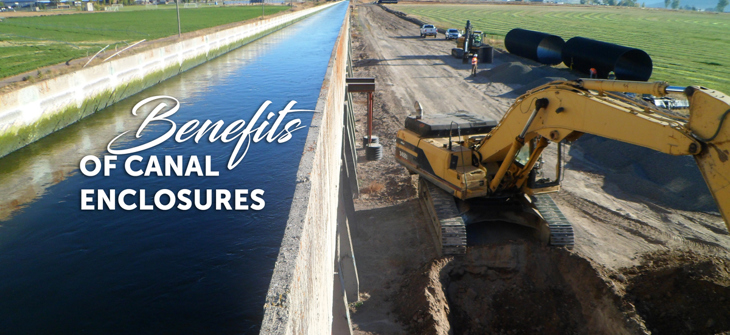
Benefits of Canal Enclosures
When people look at federal appropriations for construction or maintenance projects they don’t understand, they begin to question the necessity of those projects. The case for this blog is one of converting open irrigation channels into piped irrigation lines. If you live in the eastern half of the country, where water is much more readily available, you might look at your tax dollars going to enclose a perfectly good channel or ditch and wonder if it’s worth it. Let's take a closer look at just how important enclosing a canal may be.
The four reasons we will be discussing today are:
- Water Savings
- Maintenance
- Public Safety
- Usable Land
Irrigators will most commonly enclose their canals due to the inherent water savings, and it’s a correct perception. Open canals lose water in two ways: (1) evaporation; and (2) infiltration. Factors such as temperature, pressure, humidity, water surface area, and wind affect how much water can be lost to evaporation over an irrigation season. However, many irrigation districts report up to 20% water loss to evaporation. For infiltration, factors such as canal liner type, canal length and width, maintenance, and flow control are the primary considerations. Infiltration losses of 5% or more can affect the irrigation districts.
Of course, maintenance of all built systems greatly affects their performance. The search to reduce required maintenance has been paramount for centuries. Open channels require many forms of maintenance. Inspection, weed control, crack sealing, liner repair/patching, and structure reinforcing to name a few. All of which require time and money to keep the water flowing efficiently. Enclosed systems also require inspection and maintenance, but it’s typically limited to pipe repair in the off season.
A third reason that may not immediately come to mind is that of public safety, which is most certainly a very good reason to enclose irrigation canals. Let me pull from my own personal experience as an example. When I was a teenager, I remember my friends and I getting into trouble for jumping off a bridge into the Rum River. Beyond creating questions about my ability to make wise decisions, this also points out the fact that nothing attracts people quite like open water. People who see a chance to cool down and have some fun can seriously injure themselves or drown. Accidents can also happen. Most irrigation canals use steep side walls. Should you happen to fall into one, it makes it extremely difficult to get out. A simple Google search lists pages of deaths associated with irrigation canals.
Lastly, many irrigation districts are learning that their land can be used to generate solar energy for their use and for sale to the grid. Affixing solar panels over an irrigation canal has proven to be somewhat beneficial. However, access to these panels over water is limited, and there is the obvious risk of falling into the canal while trying to install and/or maintenance these solar panels. Conversely, once the canal is piped, solar panels can be installed directly over the pipe run with much easier access to the panels.
As with so many other topics, once we go deeper than a simple cursory impression, the dollars spent on piping canals and ditches is so much more important than we may have initially thought. Beyond increased efficiencies, beyond improved operations, saving lives is in the balance.
